陈述句变否定句一般疑问句特殊疑问句及练习
- 格式:pps
- 大小:746.50 KB
- 文档页数:32
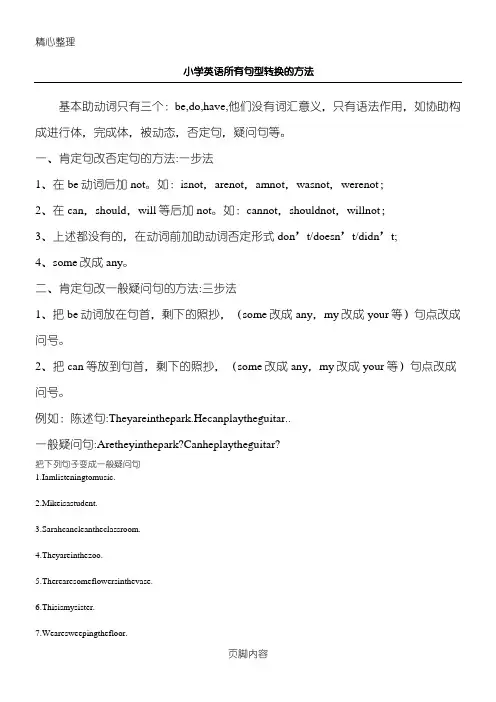
小学英语所有句型转换的方法基本助动词只有三个:be,do,have,他们没有词汇意义,只有语法作用,如协助构成进行体,完成体,被动态,否定句,疑问句等。
一、肯定句改否定句的方法:一步法1、在be动词后加not。
如:isnot,arenot,amnot,wasnot,werenot;2、在can,should,will等后加not。
如:cannot,shouldnot,willnot;3、上述都没有的,在动词前加助动词否定形式don’t/doesn’t/didn’t;4、some改成any。
二、肯定句改一般疑问句的方法:三步法1、把be动词放在句首,剩下的照抄,(some改成any,my改成your等)句点改成问号。
2、把can等放到句首,剩下的照抄,(some改成any,my改成your等)句点改成问号。
例如:陈述句:Theyareinthepark.Hecanplaytheguitar..一般疑问句:Aretheyinthepark?Canheplaytheguitar?把下列句子变成一般疑问句1.Iamlisteningtomusic._______________________________________2.Mikeisastudent._______________________________________3.Sarahcancleantheclassroom.________________________________________4.Theyareinthezoo.________________________________________5.Therearesomeflowersinthevase.________________________________________6.Thisismysister._________________________________________7.Wearesweepingthefloor.__________________________________________3、上述都没有的,在句首请助动词Do/Does/Did帮忙,剩下的照抄,(some改成any,my改成your等)句点改成问号。
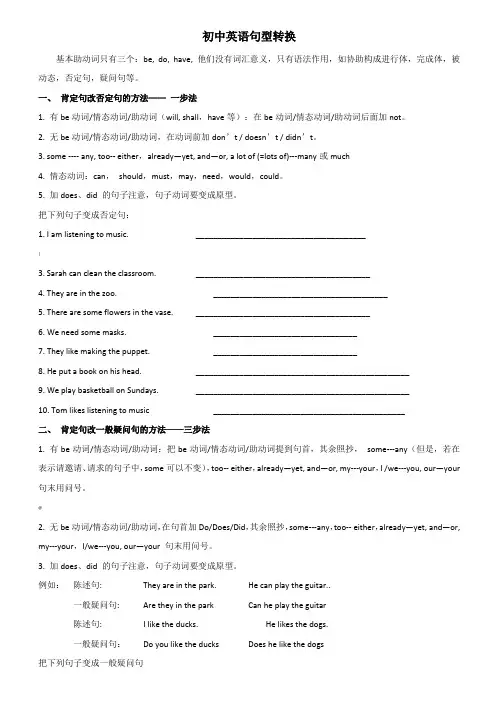
初中英语句型转换基本助动词只有三个:be, do, have, 他们没有词汇意义,只有语法作用,如协助构成进行体,完成体,被动态,否定句,疑问句等。
一、肯定句改否定句的方法——一步法1. 有be动词/情态动词/助动词(will, shall,have等):在be动词/情态动词/助动词后面加not。
2. 无be动词/情态动词/助动词,在动词前加don’t / doesn’t / didn’t。
3. some ---- any,too-- either,already—yet, and—or, a lot of (=lots of)---many或much4. 情态动词:can,should,must,may,need,would,could。
5. 加does、did 的句子注意,句子动词要变成原型。
把下列句子变成否定句:1. I am listening to music. _______________________________________|3. Sarah can clean the classroom. ________________________________________4. They are in the zoo. ________________________________________5. There are some flowers in the vase. ________________________________________6. We need some masks. _________________________________7. They like making the puppet. _________________________________8. He put a book on his head. _________________________________________________9. We play basketball on Sundays. _________________________________________________10. Tom likes listening to music ____________________________________________二、肯定句改一般疑问句的方法——三步法1. 有be动词/情态动词/助动词:把be动词/情态动词/助动词提到句首,其余照抄,some---any(但是,若在表示请邀请、请求的句子中,some可以不变),too-- either,already—yet, and—or, my---your,I /we---you, our—your 句末用问号。

初中英语句型转换基本助动词只有三个:be, do, have, 他们没有词汇意义,只有语法作用,如协助构成进行体,完成体,被动态,否定句,疑问句等。
一、肯定句改否定句的方法——一步法1. 有be动词/情态动词/助动词(will, shall,have等):在be动词/情态动词/助动词后面加not。
2. 无be动词/情态动词/助动词,在动词前加don’t / doesn’t / didn’t。
3. some ---- any,too-- either,already—yet, and—or, a lot of (=lots of)---many或much4. 情态动词:can,should,must,may,need,would,could。
5. 加does、did 的句子注意,句子动词要变成原型。
把下列句子变成否定句:1. I am listening to music. _______________________________________3. Sarah can clean the classroom. ________________________________________4. They are in the zoo. ________________________________________5. There are some flowers in the vase. ________________________________________6. We need some masks. _________________________________7. They like making the puppet. _________________________________8. He put a book on his head. _________________________________________________9. We play basketball on Sundays. _________________________________________________10. Tom likes listening to music ____________________________________________二、肯定句改一般疑问句的方法——三步法1. 有be动词/情态动词/助动词:把be动词/情态动词/助动词提到句首,其余照抄,some---any(但是,若在表示请邀请、请求的句子中,some可以不变),too-- either,already—yet, and—or, my---your,I /we---you, our—your 句末用问号。
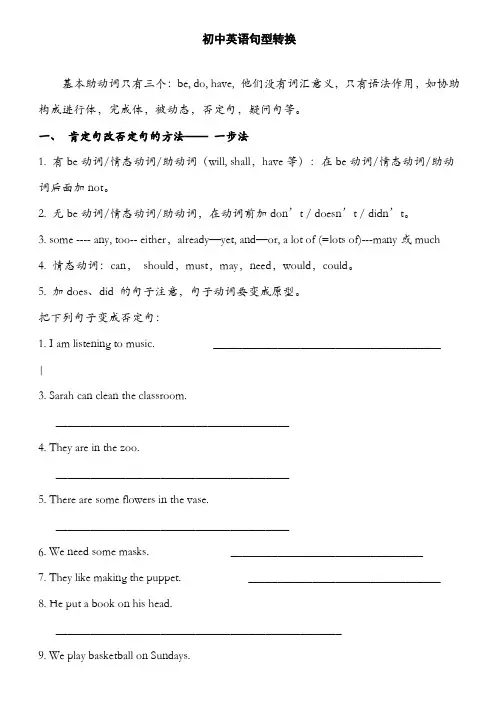
初中英语句型转换基本助动词只有三个:be, do, have, 他们没有词汇意义,只有语法作用,如协助构成进行体,完成体,被动态,否定句,疑问句等。
一、肯定句改否定句的方法——一步法1. 有be动词/情态动词/助动词(will, shall,have等):在be动词/情态动词/助动词后面加not。
2. 无be动词/情态动词/助动词,在动词前加don’t / doesn’t / didn’t。
3. some ---- any,too-- either,already—yet, and—or, a lot of (=lots of)---many或much4. 情态动词:can,should,must,may,need,would,could。
5. 加does、did 的句子注意,句子动词要变成原型。
把下列句子变成否定句:1. I am listening to music. _______________________________________|3. Sarah can clean the classroom.________________________________________4. They are in the zoo.________________________________________5. There are some flowers in the vase.________________________________________6. We need some masks. _________________________________7. They like making the puppet. _________________________________8. He put a book on his head._________________________________________________9. We play basketball on Sundays._________________________________________________10. Tom likes listening to music____________________________________________二、肯定句改一般疑问句的方法——三步法1. 有be动词/情态动词/助动词:把be动词/情态动词/助动词提到句首,其余照抄,some---any(但是,若在表示请邀请、请求的句子中,some可以不变),too-- either,already—yet, and—or, my---your,I /we---you, our—your 句末用问号。
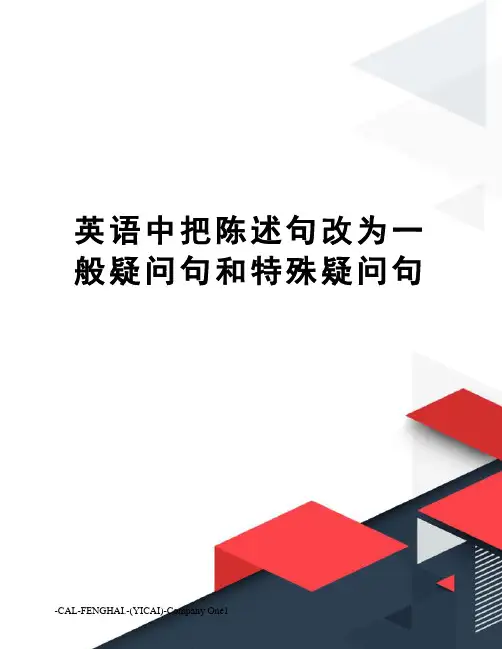
英语中把陈述句改为一般疑问句和特殊疑问句-CAL-FENGHAI.-(YICAI)-Company One1英语中把陈述句改为一般疑问句和特殊疑问句,否定句的题一、陈述句:是用来陈述一件事情或表示一种看法,可分为肯定句和否定句两种形式。
1、谓语动词是be动词,助动词have, has, will,情态动词can等时,只要直接在这些词后面加not就构成否定形式。
eg. Lily has already read this new book. (改为否定句)Lily ______ ______ this new book ________.2、谓语动词是行为动词而又没有助动词或情态动词时,必须在谓语动词前加助动词,一般现在时加助动词do ,第三人称单数加does,一般过去时加did,再和not构成否定结构。
必须指出的是:don't, doesn't, didn't后都用动词原形。
eg.1)Jill has lunch at school every day. (改为否定句)Jill _____ _____ lunch at school every day.2)The children had a good time at the party. (改为否定句)The children ______ _____ a good time at the party.3)Rose didn't drink any milk this morning.(改为肯定句)Rose ______ ______ milk this morning.二、疑问句:是用来提出问题的句子。
A.一般疑问句:以be动词, have /has/do等助动词、can/may等情态动词开头,以yes或no来回答的问句。
它的基本结构是:Be/Have /Has/Did等助动词(包括情态动词)+主语+谓语(包括表语)+┄回答常用简略回答。
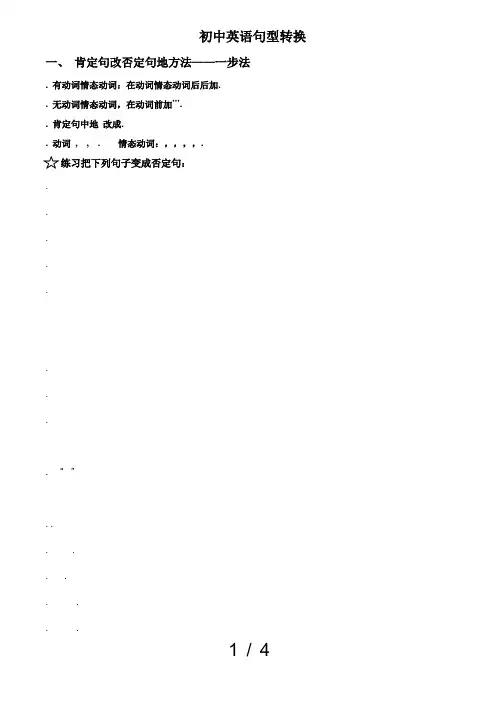
初中英语句型转换一、肯定句改否定句地方法——一步法. 有动词情态动词:在动词情态动词后后加.. 无动词情态动词,在动词前加’’’.. 肯定句中地改成.. 动词, , . 情态动词:,,,,.练习把下列句子变成否定句:......... “ ”. .. .. .. .. .二、肯定句改一般疑问句地方法——三步法. 有动词情态动词:动词情态动词提到句首,其余照抄,(改,改)句末用问号. . 无动词情态动词,在句首加,其余照抄,(改,改)句末用问号.. 加、地句子注意,句子动词要变成原型.例如:陈述句: . ..一般疑问句: ? ?陈述句: . .一般疑问句:? ?把下列句子变成一般疑问句......... “ ”. .三、肯定句改特殊疑问句地方法——四步法关于特殊疑问词问人(谁)地点(何地)时间(何时) 、 东西职业事物(什么) 方式方法程序身体(怎样) 原因 哪一个年龄 ..怎么样(提建议)多少钱谁地 (, …) 问星期 问日期问数量多少 (可数名词) (…) 问数量(不可数名词) (…) 颜色 班级 年级、在一般疑问句地基础上,句首添加一个疑问词即可,可根据划线部分确定是什么疑问词. 、接着找动词或,, 等放在疑问词后面,若没有则请助动词帮忙,写在疑问词后面, 除外,必须先写物品,再写动词等.b5E2R 。
、划线部分去掉后剩下地内容照抄,( 改成,改成等) 、句点改成问号.练一练、: ? ’ . 、: ? ’ . 、: ? ’ . 、: ? : ’ . 、: ? . 、: ? ’ . 、: ? ’ . 、: ? : . 、: ? ’ . ? : ’ . 、 ? : ’.综合练习:1. .否定句: 一般疑问句: 对划线部分提问:个人收集整理-ZQ 2. .(音乐会)否定句:一般疑问句:对划线部分提问:. .否定句:一般疑问句:肯定否定回答:. .否定句:一般疑问句:对划线部分提问:. .否定句:一般疑问句:肯定否定回答:对划线部分提问:. .否定句:一般疑问句:肯定否定回答:对划线部分提问:. .否定句:一般疑问句:肯定否定回答:对划线部分提问:. .否定句:一般疑问句:肯定否定回答:对划线部分提问:。
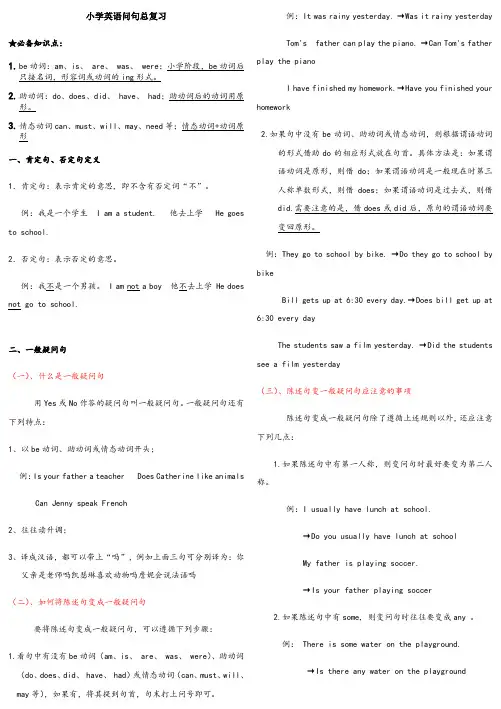
小学英语问句总复习★必备知识点:1.be动词:am、is、 are、 was、 were;小学阶段,be动词后只接名词,形容词或动词的ing形式。
2.助动词:do、does、did、 have、 had;助动词后的动词用原形。
3.情态动词can、must、will、may、need等;情态动词+动词原形一、肯定句、否定句定义1.肯定句:表示肯定的意思, 即不含有否定词“不”。
例:我是一个学生 I am a student. 他去上学 He goes to school.2.否定句:表示否定的意思。
例:我不是一个男孩。
I am not a boy 他不去上学 He does not go to school.二、一般疑问句(一)、什么是一般疑问句用Yes或No作答的疑问句叫一般疑问句。
一般疑问句还有下列特点:1、以be动词、助动词或情态动词开头;例:Is your father a teacher Does Catherine like animals Can Jenny speak French2、往往读升调;3、译成汉语,都可以带上“吗”,例如上面三句可分别译为:你父亲是老师吗凯瑟琳喜欢动物吗詹妮会说法语吗(二)、如何将陈述句变成一般疑问句要将陈述句变成一般疑问句,可以遵循下列步骤:1.看句中有没有be动词(am、is、 are、 was、 were)、助动词(do、does、did、 have、 had)或情态动词(can、must、will、may等),如果有,将其提到句首,句末打上问号即可。
例:It was rainy yesterday. →Was it rainy yesterday Tom's father can play the piano. →Can Tom's father play the pianoI have finished my homework.→Have you finished your homework2.如果句中没有be动词、助动词或情态动词,则根据谓语动词的形式借助do的相应形式放在句首。
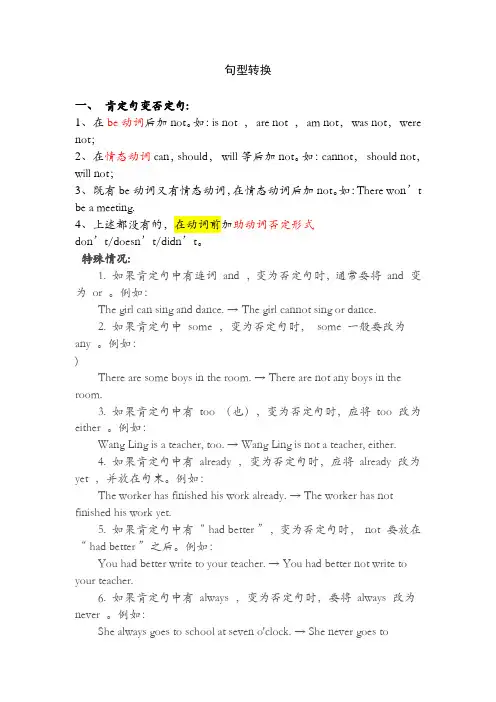
句型转换一、肯定句变否定句:1、在be动词后加not。
如:is not ,are not ,am not,was not,were not;2、在情态动词can,should,will等后加not。
如:cannot,should not,will not;3、既有be动词又有情态动词,在情态动词后加not。
如:There won’t be a meeting.4、上述都没有的,在动词前加助动词否定形式don’t/doesn’t/didn’t。
特殊情况:1. 如果肯定句中有连词and ,变为否定句时,通常要将and 变为or 。
例如:The girl can sing and dance. → The girl cannot sing or dance.2. 如果肯定句中some ,变为否定句时,some 一般要改为any 。
例如:)There are some boys in the room. → There are not any boys in the room.3. 如果肯定句中有too (也),变为否定句时,应将too 改为either 。
例如:Wang Ling is a teacher, too. → Wang Ling is not a teacher, either.4. 如果肯定句中有already ,变为否定句时,应将already 改为yet ,并放在句末。
例如:The worker has finished his work already. → The worker has not finished his work yet.5. 如果肯定句中有“ had better ”,变为否定句时,not 要放在“ had better ”之后。
例如:You had better write to your teacher. → You had better not write to your teacher.6. 如果肯定句中有always ,变为否定句时,要将always 改为never 。
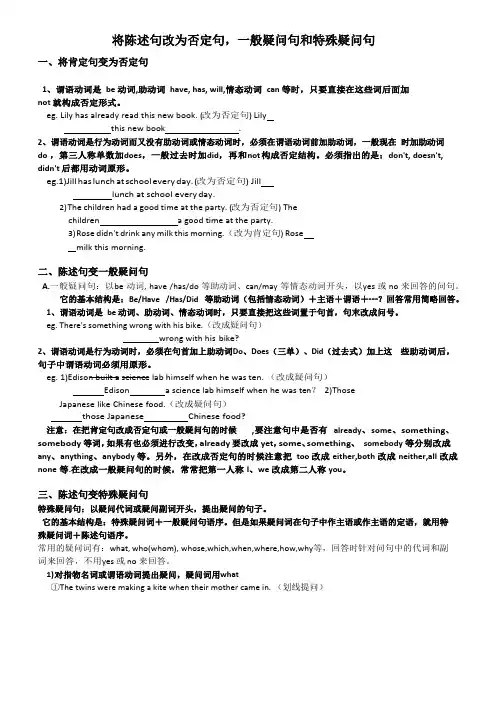
将陈述句改为否定句,一般疑问句和特殊疑问句一、将肯定句变为否定句1、谓语动词是be 动词,助动词have, has, will,情态动词can 等时,只要直接在这些词后面加not 就构成否定形式。
eg. Lily has already read this new book. (改为否定句) Lilythis new book.2、谓语动词是行为动词而又没有助动词或情态动词时,必须在谓语动词前加助动词,一般现在时加助动词do ,第三人称单数加does,一般过去时加did,再和not 构成否定结构。
必须指出的是:don't, doesn't, didn't 后都用动词原形。
eg.1)Jill has lunch at school every day. (改为否定句) Jilllunch at school every day.2)T he children had a good time at the party. (改为否定句) Thechildren a good time at the party.3)R ose didn't drink any milk this morning.(改为肯定句) Rosemilk this morning.二、陈述句变一般疑问句A.一般疑问句:以be 动词, have /has/do 等助动词、can/may 等情态动词开头,以yes 或no 来回答的问句。
它的基本结构是:Be/Have /Has/Did 等助动词(包括情态动词)+主语+谓语+┄?回答常用简略回答。
1、谓语动词是be 动词、助动词、情态动词时,只要直接把这些词置于句首,句末改成问号。
eg. There's something wrong with his bike.(改成疑问句)wrong with his bike?2、谓语动词是行为动词时,必须在句首加上助动词Do、Does(三单)、Did(过去式)加上这些助动词后,句子中谓语动词必须用原形。
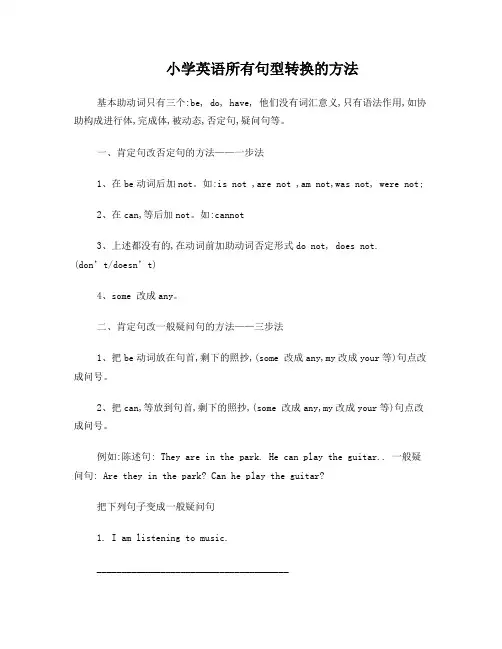
小学英语所有句型转换的方法基本助动词只有三个:be, do, have, 他们没有词汇意义,只有语法作用,如协助构成进行体,完成体,被动态,否定句,疑问句等。
一、肯定句改否定句的方法——一步法1、在be动词后加not。
如:is not ,are not ,am not,was not, were not;2、在can,等后加not。
如:cannot3、上述都没有的,在动词前加助动词否定形式do not, does not.(don’t/doesn’t)4、some 改成any。
二、肯定句改一般疑问句的方法——三步法1、把be动词放在句首,剩下的照抄,(some 改成any,my改成your等)句点改成问号。
2、把can,等放到句首,剩下的照抄,(some 改成any,my改成your等)句点改成问号。
例如:陈述句: They are in the park. He can play the guitar.. 一般疑问句: Are they in the park? Can he play the guitar?把下列句子变成一般疑问句1. I am listening to music._______________________________________2. Mike is a student._______________________________________3. Sarah can clean the classroom.________________________________________4. They are in the zoo.________________________________________5. There are some flowers in the vase.________________________________________6.This is my sister._________________________________________7.We are sweeping the floor.__________________________________________3、上述都没有的,在句首请助动词Do/Does帮忙,剩下的照抄, (some 改成any,my改成your等)句点改成问号。
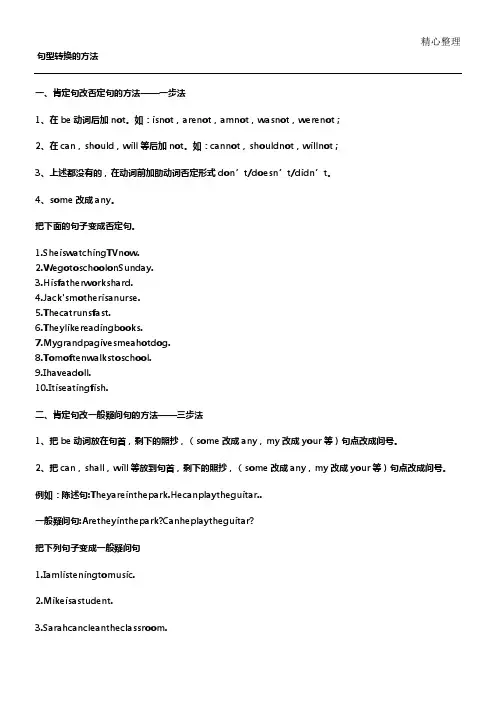
精心整理句型转换的方法一、肯定句改否定句的方法——一步法1、在be 动词后加not 。
如:isnot ,arenot ,amnot ,wasnot ,werenot ;2、在can ,should ,will 等后加not 。
如:cannot ,shouldnot ,willnot ;3、上述都没有的,在动词前加助动词否定形式don ’t/doesn ’t/didn ’t 。
4、some 1、把be 2、把can 一般疑问句:Aretheyinthepark?Canheplaytheguitar?把下列句子变成一般疑问句1.Iamlisteningtomusic.2.Mikeisastudent.3.Sarahcancleantheclassroom.4.Theyareinthezoo.5.Therearesomeflowersinthevase.6.Thisismysister.7.Wearesweepingthefloor.3、上述都没有的,在句首请助动词Do/Does/Did帮忙,剩下的照抄,(some改成any,my改成your等)句点改成问号。
1、在一般疑问句的基础上,句首添加一个疑问词即可,可根据划线部分确定是什么疑问词。
2、接着找be动词或can,shall,will等放在疑问词后面,若没有则请助动词do/does/did帮忙,写在疑问词后面,howmany除外,必须先写物品,再写be动词等。
3、划线部分去掉后剩下的内容照抄,(some改成any,my改成your等)4、句点改成问号。
句型转换题1.Thegirlissingingintheclassroom.(改为否定句)(改为一般疑问句)2.Theyarelookingforbag.(对画线部分提问)3.Iamridingmybikenow.(同上)4.Therearetwelvestudentsoverthere.(同上)5.IcanspeakEnglish.(改为一般疑问句)1.what意为“什么”,用来对“事”或“职业”提问。
小学英语问句总复习★必备知识点:1.be动词:am、is、are、was、were;小学阶段,be动词后只接名词,形容词或动词的ing形式。
2.助动词:do、does、did、have、had;助动词后的动词用原形。
3.情态动词can、must、will、may、need等;情态动词+动词原形一、肯定句、否定句定义1.肯定句:表示肯定的意思, 即不含有否定词“不”。
例:我是一个学生I am a student. 他去上学He goes to school.2.否定句:表示否定的意思。
例:我不是一个男孩。
I am not a boy 他不去上学He does not go to school.二、一般疑问句(一)、什么是一般疑问句用Yes或No作答的疑问句叫一般疑问句。
一般疑问句还有下列特点:1、以be动词、助动词或情态动词开头;例:Is your father a teacher? Does Catherine like animals?Can Jenny speak French?2、往往读升调;3、译成汉语,都可以带上“吗”,例如上面三句可分别译为:你父亲是老师吗?凯瑟琳喜欢动物吗?詹妮会说法语吗?★(二)、如何将陈述句变成一般疑问句?要将陈述句变成一般疑问句,可以遵循下列步骤:1.看句中有没有be动词(am、is、are、was、were)、助动词(do、does、did、have、had)或情态动词(can、must、will、may等),如果有,将其提到句首,句末打上问号即可。
例:It was rainy yesterday. →Was it rainy yesterday?Tom's father can play the piano. →Can Tom's father play the piano?I have finished my homework.→Have you finished your homewo rk?2.如果句中没有be动词、助动词或情态动词,则根据谓语动词的形式借助do的相应形式放在句首。
英语中把陈述句改为一般疑问句和特殊疑问句,否定句的题一、陈述句:是用来陈述一件事情或表示一种看法,可分为肯定句和否定句两种形式。
1、谓语动词是be动词,助动词have, has, will,情态动词can等时,只要直接在这些词后面加not就构成否定形式。
eg. Lily has already read this new book. (改为否定句)Lily ______ ______ this new book ________.2、谓语动词是行为动词而又没有助动词或情态动词时,必须在谓语动词前加助动词,一般现在时加助动词do ,第三人称单数加does,一般过去时加did,再和not构成否定结构。
必须指出的是:don't, doesn't, didn't后都用动词原形。
Jill has lunch at school every day. (改为否定句)Jill _____ _____ lunch at school every day.2)The children had a good time at the party. (改为否定句)The children ______ _____ a good time at the party.3)Rose didn't drink any milk this morning.(改为肯定句)Rose ______ ______ milk this morning.二、疑问句:是用来提出问题的句子。
A.一般疑问句:以be动词, have /has/do等助动词、can/may等情态动词开头,以yes或no来回答的问句。
它的基本结构是:Be/Have /Has/Did等助动词(包括情态动词)+主语+谓语(包括表语)+┄回答常用简略回答。
1、谓语动词是be动词、助动词、情态动词时,只要直接把这些词置于句首,句末改成问号。
eg. There's something wrong with his bike.(改成疑问句)______ _____ _______ wrong with his bike2、谓语动词是行为动词时,必须在句首加上助动词Do、Does(三单)、Did(过去式)加上这些助动词后,句子中谓语动词必须用原形。
一、肯定句改否定句的方法——一步法1、在be动词后加not。
如:is not ,are not ,am not,was not,were not;2、在can,等后加not。
如:cannot3、上述都没有的,在动词前加助动词否定形式do not, does not. (don’t/doesn’t)4、some 改成any。
二、肯定句改一般疑问句的方法——三步法1、把be动词放在句首,剩下的照抄,(some 改成any,my改成your等)句点改成问号。
2、把can,等放到句首,剩下的照抄,(some 改成any,my改成your等)句点改成问号。
例如:陈述句: They are in the park. He can play the guitar..一般疑问句: Are they in the park? Can he play the guitar?把下列句子变成一般疑问句1.I am listening to music._______________________________________2.Mike is a student._______________________________________3.Sarah can clean the classroom.________________________________________4.They are in the zoo.________________________________________5. There are some flowers in the vase.________________________________________6. This is my sister._________________________________________7. We are sweeping the floor.__________________________________________3、上述都没有的,在句首请助动词Do/Does帮忙,剩下的照抄,(some 改成any,my改成your等)句点改成问号。
初一英语语法--句型转换(详细内容)初一英语语法—句型转换内容:陈述句:肯定句否定句疑问句:一般疑问句特殊疑问句一.肯定句变否定句1.句子中有be,在be后加not。
(be动词有am , is , are, was, were)1)I am a student. I am not a student.2)They are blue . They aren’t blue.3) He is Kangkang. He is n’t Kangkang .4) I was ten last year. I wasn't ten yesterday.5) He was good at English. He wasn't good at English.6) They were at home last Sunday. They weren't at home last Sunday.练习:把下列句子变为否定句1.His father is an English teacher._____________________________2.He is crying under the tree. ___________________________ __3.He was thirteen years old two years ago._______________________4.They are very lucky.______________________________________5.t the family was poor.6.My voice was too weak.2.谓语是动词原形,在动词前加don’t。
7.I have a book . I don’t have a book.8.They like Chinese . They don’t like Chinese.9.3) We come from China. We don’t come from China.3.谓语动词是第三人称单数,在动词前加doesn’t,动词用原形。
小学英语所有句型转换的方法基本助动词只有三个:be, do, have, 他们没有词汇意义,只有语法作用,如协助构成进行体,完成体,被动态,否定句,疑问句等。
一、肯定句改否定句的方法——一步法1、在be动词后加not。
如:is not ,are not ,am not,` was not,were not;2、在can,should,will等后加not。
如:cannot,should not,will not;3、在动词前加助动词的否定形式don’t/doesn’t。
4、some 改成any。
1. We need some food.We don’t need any food.2. They like going hiking._________________________________3. She lives in China.______________________________________ ___________4.His name is john.______________________________________ ___________6.We play basketball on Sunday. ______________________________________ ___________7. Tom doesn’t like listening tomusic.______________________________________ ______二、肯定句改一般疑问句的方法——三步法1、把be动词放句首,剩下的照抄,(some 改成any,my改成your,I am改成Are you等),句号改成问号。
2、把can,shall,will等放句首,剩下的照抄,(some 改成any,my改成your 等)句号改成问号。
例如:陈述句: They are in the park. He can play the guitar..一般疑问句: Are they in the park?Can he play the guitar?把下列句子变成一般疑问句,作否定回答1. Are you listening to music? _______________________________________ 2. Mike is a student._______________________________________ 3. Sarah can clean the classroom.________________________________________ 4. They are in the zoo.________________________________________ 5. This is my sister._________________________________________ 3、上述都没有的,在句首请助动词Do/Does帮忙,剩下的照抄,(some 改成any,my改成your等)句点改成问号。